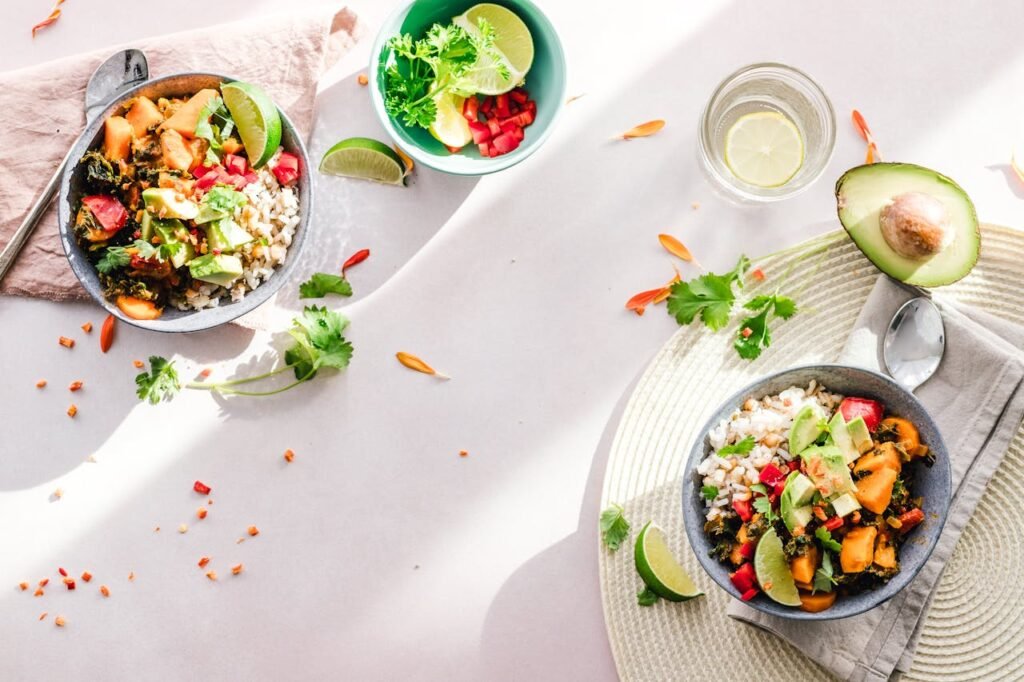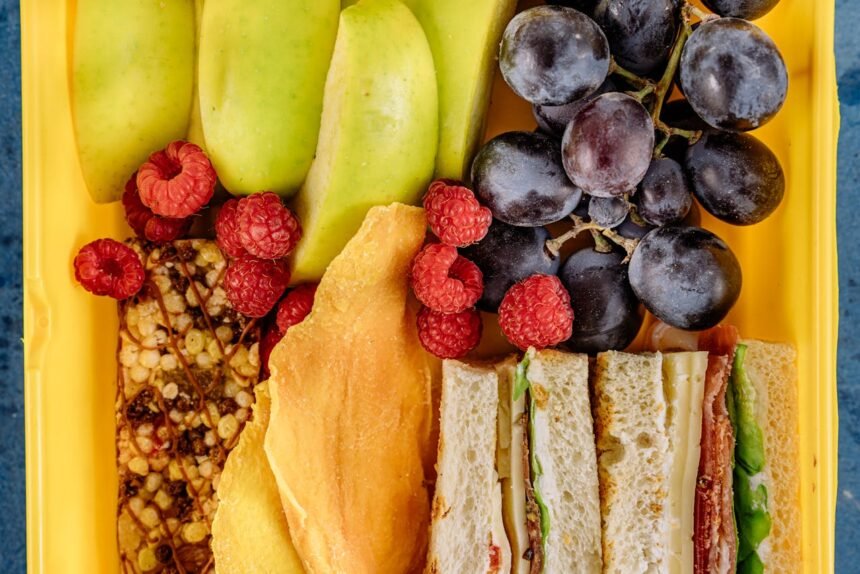Successful adherence to the Mediterranean diet requires strategic meal planning that incorporates the diverse ingredients and flavours characteristic of this heart-healthy eating pattern. By planning weekly menus and organising shopping lists around Mediterranean diet principles, families can ensure they consistently include the vegetables, healthy fats, whole grains, and lean proteins that make this dietary approach so beneficial for long-term health.
Principles of Mediterranean Meal Planning
The Mediterranean diet emphasises abundance rather than restriction, focusing on fresh, seasonal ingredients prepared simply to highlight their natural flavours. Effective meal planning for this eating pattern requires understanding core components whilst maintaining flexibility for personal preferences and seasonal availability.
The British Heart Foundation provides guidance on Mediterranean-style eating at https://www.bhf.org.uk/informationsupport/heart-matters-magazine/nutrition/mediterranean-diet emphasising that this dietary pattern can be adapted to UK ingredients and preferences whilst maintaining its health benefits.
Foundation Foods for Weekly Planning
Daily Vegetables: Plan for 5-9 servings of vegetables daily, incorporating variety through different colours, textures, and preparation methods throughout the week.
Healthy Fats: Extra virgin olive oil serves as the primary cooking fat and salad dressing, with nuts, seeds, and avocados providing additional healthy fat sources.
Protein Rotation: Include fish and seafood at least twice weekly, with legumes, eggs, and moderate amounts of poultry filling remaining protein needs.
Whole Grains: Brown rice, quinoa, wholemeal pasta, and other minimally processed grains provide sustained energy and fibre throughout the week.
Fresh Herbs: Basil, oregano, parsley, and other fresh herbs add flavour without sodium whilst providing beneficial plant compounds.
Weekly Menu Structure
Breakfast Planning
Mediterranean breakfasts typically emphasise protein, healthy fats, and fresh produce rather than refined carbohydrates and added sugars.
Monday: Greek yoghurt with berries, walnuts, and honey
Tuesday: Vegetable frittata with wholemeal toast
Wednesday: Overnight oats with almonds and fresh fruit
Thursday: Avocado toast with tomatoes and feta
Friday: Smoothie bowl with spinach, banana, and nuts
Saturday: Weekend pancakes with fresh fruit
Sunday: Extended brunch with smoked salmon and vegetables
Planning Tips: Prepare overnight oats and chia puddings in advance. Keep Greek yoghurt, nuts, and fresh fruit readily available for quick assembly. Batch-cook frittatas for easy reheating throughout the week.
Lunch Planning
Mediterranean lunches often feature salads, legume-based dishes, and light proteins that provide sustained energy without heaviness.
Monday: Quinoa tabbouleh with chickpeas
Tuesday: Greek salad with white beans
Wednesday: Lentil soup with wholemeal bread
Thursday: Hummus and vegetable wrap
Tuesday: Niçoise salad with tuna
Saturday: Leftover dinner portions
Sunday: Family-style mezze platter
Preparation Strategies: Cook grains and legumes in large batches for use throughout the week. Prepare salad components in advance, storing wet and dry ingredients separately. Make large pots of soup for multiple meals.
Dinner Planning
Evening meals provide opportunities for family gathering around shared Mediterranean-style dishes that emphasise vegetables, healthy proteins, and communal eating.
Monday: Herb-crusted salmon with roasted vegetables
Tuesday: Chickpea and vegetable curry over brown rice
Wednesday: Grilled chicken with Mediterranean quinoa salad
Thursday: Pasta primavera with seasonal vegetables
Friday: Fish and vegetable parcels with herbs
Saturday: Homemade pizza with vegetable toppings
Sunday: Family-style roasted chicken with root vegetables
Cooking Strategies: Prepare marinades and spice blends in advance. Use sheet pan cooking for easy preparation and cleanup. Plan for intentional leftovers that become next-day lunches.
The NHS provides guidance on balanced meal planning at https://www.nhs.uk/live-well/eat-well/food-guidelines/the-eatwell-guide/ which aligns well with Mediterranean diet principles when emphasising vegetables, healthy fats, and whole grains.

Seasonal Menu Adaptations
Spring Menus (March-May)
Spring brings fresh asparagus, peas, artichokes, and early herbs that add vibrant flavours to Mediterranean meals.
Featured Ingredients: Asparagus, peas, broad beans, spring onions, fresh herbs, strawberries, and early summer vegetables.
Sample Week:
- Breakfasts: Spring vegetable frittata, strawberry yoghurt bowls, herbed scrambled eggs
- Lunches: Asparagus and pea salad, spring minestrone, pea and mint hummus wraps
- Dinners: Grilled fish with spring vegetables, pea risotto, lamb with herbs and artichokes
Shopping Focus: Visit local farmers’ markets for the freshest spring produce. Plan menus around available seasonal ingredients rather than forcing specific recipes.
Summer Menus (June-August)
Summer abundance allows for fresh, light meals that require minimal cooking whilst showcasing peak-season produce.
Featured Ingredients: Tomatoes, courgettes, aubergines, peppers, berries, stone fruits, fresh herbs, and salad greens.
Sample Week:
- Breakfasts: Fresh fruit and yoghurt, gazpacho shots, melon and prosciutto
- Lunches: Gazpacho with accompaniments, Greek village salad, grilled vegetable wraps
- Dinners: Ratatouille, grilled fish and vegetables, cold poached salmon salads
Cooking Strategies: Utilise outdoor grilling to keep kitchens cool. Prepare cold soups and salads that require no heating. Focus on raw and lightly cooked preparations.
Autumn Menus (September-November)
Autumn harvests provide heartier vegetables perfect for warming Mediterranean-style stews and roasted dishes.
Featured Ingredients: Butternut squash, Brussels sprouts, apples, pears, pomegranates, root vegetables, and warming spices.
Sample Week:
- Breakfasts: Apple and walnut porridge, roasted vegetable hash, spiced pear yoghurt
- Lunches: Butternut squash soup, autumn grain salads, roasted vegetable frittata
- Dinners: Moroccan-style tagines, roasted chicken with root vegetables, hearty bean stews
Preparation Methods: Embrace longer cooking methods like braising and roasting. Prepare warming spice blends that complement autumn flavours.
Winter Menus (December-February)
Winter planning focuses on preserved ingredients, hearty stews, and comforting dishes that maintain Mediterranean principles whilst providing warming satisfaction.
Featured Ingredients: Citrus fruits, cabbages, leeks, preserved tomatoes, dried fruits, nuts, and warming spices.
Sample Week:
- Breakfasts: Citrus and yoghurt bowls, winter vegetable hash, warming porridge with nuts
- Lunches: White bean and kale soup, winter grain salads, hearty lentil stews
- Dinners: Braised chicken with vegetables, fish stews, pasta with winter vegetables
Storage Strategies: Utilise preserved tomatoes, frozen vegetables, and pantry staples. Focus on longer-cooking methods that develop deep flavours.
Shopping List Organisation
Pantry Staples (Monthly Shopping)
Oils and Vinegars: Extra virgin olive oil, balsamic vinegar, red wine vinegar, lemon juice (fresh or bottled)
Grains and Legumes: Brown rice, quinoa, wholemeal pasta, rolled oats, dried lentils, canned beans (various types), canned chickpeas
Nuts and Seeds: Almonds, walnuts, pine nuts, pistachios, sunflower seeds, pumpkin seeds, tahini
Canned Goods: Canned tomatoes, tomato paste, canned fish (salmon, tuna, sardines), vegetable and chicken stock
Herbs and Spices: Dried oregano, thyme, basil, cumin, paprika, cinnamon, sea salt, black pepper
Condiments: Capers, olives (various types), mustard, honey, vanilla extract
Weekly Fresh Shopping
Proteins: Fresh fish and seafood (2-3 times weekly), free-range eggs, Greek yoghurt, occasional poultry
Vegetables: Seasonal vegetables in variety, leafy greens, tomatoes, onions, garlic, lemons
Fruits: Seasonal fresh fruits, berries when available, citrus fruits
Fresh Herbs: Parsley, basil, cilantro, dill, mint (based on weekly menu needs)
Dairy: Feta cheese, fresh mozzarella, parmesan (small amounts for flavour)
Seasonal Specialty Items
Spring: Asparagus, artichokes, peas, broad beans, spring onions, fresh herbs
Summer: Tomatoes, courgettes, aubergines, peppers, berries, stone fruits
Autumn: Winter squashes, Brussels sprouts, apples, pears, pomegranates
Winter: Citrus fruits, cabbages, leeks, root vegetables, preserved tomatoes
British Nutrition Foundation guidance on meal planning can be found at https://www.nutrition.org.uk/putting-it-into-practice/food-planning/ emphasising the importance of planning balanced meals that include diverse nutrients.
Budget-Friendly Mediterranean Planning
Cost-Effective Protein Strategies
Legume Emphasis: Plan several meals weekly around beans, lentils, and chickpeas, which provide protein at fraction of meat costs.
Seasonal Fish Choices: Select fish based on seasonal availability and local pricing rather than specific varieties, maintaining omega-3 benefits whilst controlling costs.
Egg Versatility: Incorporate eggs into multiple meal categories, from breakfast frittatas to dinner shakshuka, for economical high-quality protein.
Smart Seafood Shopping: Purchase frozen fish and seafood when fresh options are expensive, maintaining nutritional benefits at lower costs.
Economical Vegetable Strategies
Seasonal Focus: Plan menus around vegetables that are in season and locally available to maximise nutrition whilst minimising costs.
Versatile Vegetables: Choose vegetables that work in multiple preparations, such as tomatoes for fresh salads, cooked sauces, and preserved options.
Batch Preparation: Buy larger quantities of sale vegetables and prepare them for multiple uses throughout the week.
Frozen Options: Incorporate frozen vegetables when fresh options are expensive, particularly for cooked dishes where texture differences are minimal.
Pantry Optimisation
Bulk Buying: Purchase grains, legumes, nuts, and spices in bulk quantities to reduce per-unit costs whilst ensuring freshness through proper storage.
Seasonal Preservation: Make larger quantities of seasonal items like tomato sauce or pesto when ingredients are abundant and inexpensive.
Generic Brands: Choose store-brand canned goods, grains, and basic ingredients that offer equivalent nutrition at lower costs.
Meal Prep Strategies
Weekend Preparation Sessions
Grain Cooking: Prepare large batches of brown rice, quinoa, and other grains for use throughout the week in various dishes.
Vegetable Prep: Wash, chop, and partially cook vegetables that will be used in multiple meals, storing them properly for easy assembly.
Sauce and Dressing Preparation: Make larger quantities of frequently used items like tahini dressing, tomato sauce, and herb oils.
Protein Preparation: Cook proteins that can be used in multiple ways throughout the week, such as roasted chicken or hard-boiled eggs.
Daily Assembly Strategies
Mix and Match Components: Prepare versatile components that can be combined differently each day to create varied meals from similar ingredients.
Fresh Element Addition: Add fresh herbs, citrus juice, or raw vegetables to prepared components to maintain freshness and variety.
Temperature Variation: Serve prepared components hot, cold, or at room temperature to create different meal experiences from the same ingredients.
Storage and Safety Considerations
Proper Containers: Use appropriate storage containers that maintain food safety whilst preserving texture and flavour of prepared components.
Labelling Systems: Clearly label prepared items with contents and preparation dates to ensure proper rotation and food safety.
Temperature Management: Understand which prepared foods store well at different temperatures and plan accordingly for food safety.
Age UK provides practical guidance on meal planning for older adults at https://www.ageuk.org.uk/information-advice/health-wellbeing/healthy-eating/ including strategies for maintaining nutrition whilst managing preparation challenges.
Family Adaptation Strategies
Accommodating Different Preferences
Base Plus Additions: Prepare neutral base dishes that can be customised with different toppings, sauces, or additions to suit individual preferences.
Gradual Introduction: Slowly introduce new Mediterranean ingredients and flavours rather than making dramatic changes that might meet resistance.
Familiar Preparations: Adapt familiar family recipes to include more Mediterranean ingredients whilst maintaining recognisable flavours and presentations.
Choice Integration: Offer choices within Mediterranean framework, such as different protein options or vegetable preparations, to maintain autonomy whilst supporting healthy eating.
Children-Friendly Adaptations
Texture Modifications: Adapt Mediterranean dishes to suit children’s texture preferences whilst maintaining nutritional integrity.
Familiar Flavours: Start with milder Mediterranean flavours and gradually build complexity as children’s palates develop.
Interactive Elements: Include foods that children can assemble themselves, such as personal pizzas with vegetable toppings or build-your-own grain bowls.
Educational Opportunities: Use meal planning and preparation as opportunities to teach children about nutrition, cooking, and cultural food traditions.
Special Dietary Accommodations
Gluten-Free Adaptations: Substitute gluten-containing grains with naturally gluten-free options like quinoa, rice, and certified gluten-free products.
Dairy-Free Modifications: Use nutritional yeast, cashew cream, or dairy-free alternatives to maintain flavours whilst accommodating lactose intolerance or dairy allergies.
Vegetarian Variations: Emphasise the naturally plant-forward aspects of Mediterranean eating whilst ensuring adequate protein through legume and egg inclusion.
Low-Sodium Modifications: Rely on herbs, spices, citrus, and vinegar for flavouring rather than salt, whilst being mindful of canned product sodium content.

Technology Integration
Digital Planning Tools
Meal Planning Apps: Utilise smartphone applications that help organise weekly menus, generate shopping lists, and track ingredient usage to minimise waste.
Recipe Scaling: Use online tools to scale Mediterranean recipes up or down based on family size and planned leftover usage.
Seasonal Calendars: Access digital resources that indicate peak seasons for various ingredients to optimise menu planning and costs.
Shopping Integration
Digital Lists: Create shopping lists on smartphones that can be updated throughout the week and shared with family members who shop.
Price Comparison: Use apps that compare prices across different stores to optimise food budgets whilst maintaining ingredient quality.
Inventory Tracking: Maintain digital inventories of pantry staples to avoid over-purchasing whilst ensuring necessary ingredients are always available.
Troubleshooting Common Challenges
Time Management Issues
Simplified Preparations: Focus on simple Mediterranean preparations that require minimal time whilst maintaining nutritional benefits and authentic flavours.
Batch Strategies: Utilise weekend preparation time to create components that make weekday meal assembly quick and efficient.
Flexible Timing: Develop menu plans that can accommodate varying daily schedules whilst maintaining Mediterranean eating principles.
Ingredient Availability
Substitution Strategies: Learn appropriate substitutions for Mediterranean ingredients that may be difficult to find or expensive in certain locations.
Seasonal Flexibility: Develop comfort with adapting recipes based on available ingredients rather than rigidly following specific ingredient lists.
Local Sourcing: Identify local sources for Mediterranean-style ingredients, including ethnic markets, farmers’ markets, and specialty stores.
Budget Constraints
Priority Ingredients: Identify which Mediterranean ingredients provide the most nutritional and flavour impact for the cost, prioritising these in tight budgets.
Seasonal Planning: Plan more elaborate Mediterranean meals during seasons when key ingredients are abundant and less expensive.
Batch Economics: Prepare larger quantities of expensive ingredients when they’re on sale, preserving or freezing portions for later use.
Conclusion
Successful Mediterranean diet meal planning requires balancing nutritional goals with practical considerations including budget, time, family preferences, and ingredient availability. By focusing on seasonal ingredients, strategic shopping, and flexible preparation methods, families can consistently enjoy the health benefits and delicious flavours of Mediterranean eating.
The key to sustainable Mediterranean meal planning lies in viewing it as a flexible framework rather than a rigid set of rules. Adapt the principles to suit your circumstances whilst maintaining focus on vegetables, healthy fats, whole grains, and moderate amounts of high-quality proteins.
Remember that Mediterranean eating represents more than just individual meals—it encompasses a lifestyle approach that values fresh ingredients, shared meals, and the pleasure of eating well. Successful meal planning supports not only nutritional goals but also the social and cultural aspects that make Mediterranean eating both healthful and enjoyable for the whole family.






